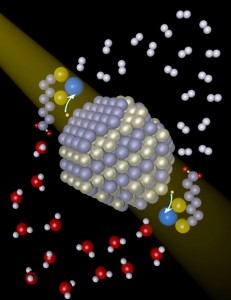How to convert water into fuel using sunlight
 One of the first real science words I learned with “photosynthesis.” It’s how sunlight is converted into energy, and it’s what makes plants different from us.
One of the first real science words I learned with “photosynthesis.” It’s how sunlight is converted into energy, and it’s what makes plants different from us.Well now, scientists have found a way to mimic photosynthesis, using sunlight to convert water into a fuel.
Specifically, they discovered a catalyst that uses energy in sunlight to generate hydrogen gas, which is a carbon-free fuel. This could lead to systems that use sunlight to split water molecules, generating a clean-burning fuel that can power cars without emitting any greenhouse gases. ScienceNOW reports.
[Plants] capture photons of sunlight and use that energy to split water molecules into their constituents of hydrogen and oxygen ions. Pairs of hydrogen ions are then knitted together with a pair of electrons (swiped from the oxygen ions) to make hydrogen molecules.
For artificial photosynthesis to be relatively cheap, you need two key ingredients: a good light absorber and a good catalyst.
•The light absorber captures photons of sunlight and then harnesses the energy to generate the energetic electrons.
•Those energized electrons are then passed to the catalyst, which knits the hydrogen ions into hydrogen molecules.
To make hydrogen fuel from a solution of water, University of Rochester researchers used semiconducting nanoparticles as light absorbers and a nickel catalyst to grab electrons and knit hydrogen molecules together.
The work was published in Science last week. Pictured: light hits the nanoparticle, an electron is transferred to the nickel catalyst (blue), and hydrogen (white) is produced.
Meanwhile, to help improve artificial photosynthesis, a team at Umeå University in Sweden has developed a set-up for imaging how real photosynthesis splits water into its constituent parts – in hopes of helping engineers more cheaply synthesize hydrogen gas to power hydrogen fuel cells and automobiles powered by them, IEEE Spectrum reports.
You can return to the main Market News page, or press the Back button on your browser.

